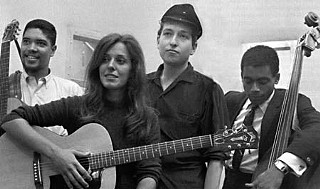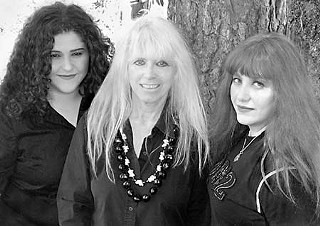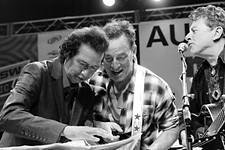Double-Barrel Beautiful
How Carolyn Hester of Waco rose to the height of the folk revival, gave Bob Dylan his break, and lived to tell the tale
By Margaret Moser, Fri., Dec. 19, 2008

"The events which led up to [recording for Columbia Records] were very unexpected. ... John [Hammond] had first seen and heard me at Carolyn Hester's apartment. Carolyn was a Texan guitar-playing singer who I knew and played with around town. She was going places and it didn't surprise me. Carolyn was eye catching, down-home and double barrel beautiful. That she had known and worked with Buddy Holly left no small impression on me and I liked being around her. Buddy was royalty, and I felt like she was my connection to it, to the rock-and-roll music that I'd played earlier, to that spirit." – Bob Dylan, Chronicles
Carolyn Hester's life resembles a great woven mandala, the Sanskrit word for circle, never-ending and overlapping music with life and people. Within its intricate design, the past is thick with threads of ancient ballads and long-forgotten tunes worked into the modern consciousness. All elements flow over and under one another with organic grace in the mandala's remarkable marriage of mathematics and art.
By mere association, Hester resides in a golden aura. She arrived in New York City in 1955, ready to study theatre, because it pleased her mother to "know where I was at least part of the time." Instead, she tumbled into the nascent 1960s folk movement. Finding her true voice in singing, she fell in with a crowd that admired the Weavers and the king and queen of folk, Pete Seeger and the late Odetta.
Hester quickly became the Texan sweetheart of the folk rodeo, and by 1958, she'd recorded Scarlet Ribbons with Norman Petty at his famous Clovis, N.M., studio. There she befriended an ambitious local teen by the name of Buddy Holly and was pleased when he accompanied her on some of the recordings. Her third LP appeared on the prestigious Columbia Records label, produced by the estimable John Hammond, who took note of Hester's harmonica player and soon signed the young Bob Dylan. In 1964, the Saturday Evening Post put her on the cover.
The music of Hester's generation flourished in the mid-1960s, morphing into folk rock when Dylan plugged in at Newport in 1965, dear old-school Seeger trying to pull the plug. The British were coming, and times were a-changing.
Hester married composer-musician David Blume in 1969, and four years later, she released her third self-titled LP, this time for RCA. It was the last time Hester would record on her own until Texas Songbird in 1996.
Scarlet Ribbons
"I was born in 1937, so this recession feels familiar," begins Carolyn Hester, chuckling on the telephone from her home outside Los Angeles.
In 1937, The Hobbit first appeared in print, the Hindenburg exploded, Amelia Earhart vanished, the Marijuana Tax Act became law, and Robert Johnson recorded his last songs. Waco was her birthplace, yet her music-loving parents moved more than once during her childhood. A choir scholarship paid for singing lessons, and during a Dallas high school production, Hester's performance of "The Kerry Dance" impressed a PE teacher, who introduced the aspiring vocalist to the music of folksinger Susan Reed.
"[The teacher] brought me an album of Susan's, and I took it home and listened to it. It was the first time I'd heard a woman in folk music, and she was playing her own instruments – zither, I think. After hearing Susan, I became interested in folk instruments, and I started playing guitar.
"I had an old Silvertone my dad got at Sears. My fingers bled, I'm telling you. It was very hard to play. Then I got a Martin. I think that one got stolen when my apartment got broken into in New York. But I carried guitars many a mile, to towns I played. And it's a very lonely occupation, a daunting experience to go to a new town where basically you're it. You've gotta fight the loneliness. It was like that when I moved to New York in 1955."
Hester enrolled in the American Theatre Wing to further her career in the arts, but that was mainly to appease her mother, now living back in Texas. Her mother heard a radio interview with a regional vocal trio named the Roses and decided to find out if they knew anything that could help her daughter.
"My mother found out about Norman Petty in Clovis because she'd called the radio station, and they told her about him. So she wrote him a penny postcard, and he called her! She said, 'Do you audition local talent?' which was funny because Buddy was local talent. That's how I met Buddy and Norman. My first album was on Coral, and Buddy was on Brunswick, both part of Decca.
"My first album was recorded in 1957 and came out in 1958, Scarlet Ribbons. I recorded other albums, then Norman and I got back together and recorded At Town Hall. In fact, I imported George Tomsco of the Fireballs to play guitar for me at Town Hall, too. Norman wheeled a tape machine into Town Hall in 1965 and recorded me, so that's one of the few live concerts by a female folksinger from that era. We had a terrific time."
Folk Music Fad
At Town Hall was still several years in the future in the waning weeks of September 1961, when John Hammond brought Hester into the studio to record her Columbia debut. The session was key for Hester, her third recording, and one her prestigious sponsor hoped would surpass Joan Baez, a lovely young soprano with a three-octave range who was the other female voice of folk. Carolyn Hester was a critical hit already, but it was Bob Dylan that made the recording historical.
"Extremely magnetic, he was different-looking from everyone else," states Hester. "I grew up around people named Boogerweed and Doak – Bob didn't look like any of those. He was thin, rather small, very, very pale. He had long fingernails on his right hand to pluck the guitar. He had great power onstage. He was really different. It's vital for the young to realize the power of their own ability.
"Bob started with a pencil and a piece of paper."
Hester's decision to surround herself with musicians was innovative, and her Columbia sessions remain some of the earliest mixed-race, mixed-gender recordings. Dylan was green compared to guitarist Bruce Langhorne, who would continue to play alongside Dylan, and noted bassist Bill Lee, whose son, Spike, took up filmmaking.
"The 'band' I gathered for the Columbia album came about because Bruce was playing guitar for me already, and I requested Bill on the sessions because I loved the work he did on Odetta recordings. I had worked with George Atwood playing bass on Scarlet Ribbons, my dad had played harmonica, and Jerry Allison, Buddy's drummer, played brushes on a cardboard box, so I was already into guitar, harmonica, and bass before I met Dylan.
"The apartment where John Hammond came to hear my band and where I introduced him to Dylan was on West 10th Street in Greenwich Village, a friend's apartment. Dylan asked to be on the record, came asking me about gigs. I told him I had a guitar player on my Columbia session, but my dad had played harmonica on my first album so I asked Bob if he would consider playing harp. He said he would. The rest is history, right back to that pencil and piece of paper."
That 1962 album, the second of three self-titled LPs throughout her career, contained 12 folk standards typical of the times, including "I'll Fly Away," the bluesy "Come Back Baby," and her own "Pobre de Mi." It was followed in 1963 with This Life I'm Living, less celebrated but more adventurous, with an early version of "House of the Rising Sun" and dabbles into Latin rhythms.
Übermanager Albert Grossman took control of Hester's career for a time, but she declined his suggestion to team with two male singer-songwriter/players, thus missing the opportunity to have been known as Peter Paul & Carolyn. Hootenanny hit TV the spring of 1963. Regarded with great suspicion by a folk community that believed it to be a crass exploitation of the genre's roots in cultural balladry and social consciousness, the show was nonetheless a huge success.
Hester appeared on the first season, but when the network banned Pete Seeger, she shunned the program, as did the big-name folkies. Hootenanny was canceled amid cultural upheaval only 18 months after it first aired. The country reeled in confusion after President Kennedy's assassination in November 1963. When Hester appeared on the cover of The Saturday Evening Post in May 1964, the clueless title said it all: "Folk-Music Fad."
Hootenanny tanked in September, just seven months after the Beatles stole the heart of America. The momentum propelling Carolyn Hester's career ran out of steam not long after the 1965 release of At Town Hall. The period preceding it had been tumultuous. Her marriage to Richard Fariña, whose book Been Down So Long It Looks Like Up to Me became de rigueur reading in the 1960s, imploded when he fell for Joan Baez' teenage sister, Mimi. Tired of his bullying, Miss Double-Barrel Beautiful leveled a single barrel at the philandering Fariña in a Paris hotel room. The pistol's safety was on, but she flew west and filed for a Mexican divorce.
Performances were still the mainstay of Hester's career throughout the rest of the decade, and she often returned to Texas, playing Aqua Fest in Austin after the release of This Life I'm Living. Among those lined up for autographs afterward was young Nanci Griffith. Hester also appeared at the Chequered Flag, a Guadalupe Street bar later known as the Pink Lizard, Buffalo Gap, Gemini's, Raul's, and for 22 years, the Texas Showdown.
"I played at all kinds of watering holes and steak houses," she recalls. "Rod Kennedy booked me at lots of venues [around] UT. Plus, Austin television was very welcoming. Texas was vital in my getting out there and playing music. Dylan even said that Texas was the first place they didn't boo him for going electric."
This Life I'm Living
A jazz musician and producer, David Blume came into Hester's life after his 1966 hit for the Cyrkle, "Turn Down Day." The couple married in 1969, and they headed west to California in 1973. Her three ensuing LPs included an ill-advised psychedelic coloring, and when two girls, Karla and Amy, were born to the two musicians, Hester was content to mother them, effectively dropping out.
Truth be told, there was little demand for Hester's brand of musical interpretation by the end of the 1960s. Folk-rock superseded folk, Joan Baez evolved into songwriting, and fellow songbird Judy Collins emerged as the new voice of folk, up-and-comers such as Joni Mitchell plying a strong combination of singing and songwriting. Hester wrote songs, but her primary talent lay in the appealing combination of a clear soprano, mannered guitar playing, and a canny choice of compositions that appealed to casual listeners as well as folk fans.
In Texas, in an atmosphere thick with progressive country and a lingering taste for songwriters and acoustic music, the Kerrville Folk Festival was born in 1972. Festival co-founder Rod Kennedy brought Hester in the first year, cementing a long-term professional relationship and friendship. The annual festival was the perfect way to babysit the muse while Hester raised Karla and Amy and ran a club with her husband in California. They kept it open until his death in 2006.
"The Kerrville festivals were the happiest memories I have," reveals Hester. "I don't know how many Kerrville festivals I did, 36 I guess if they started in '72. It's really blossomed since then – Bonnie Hearne and I were the only gals that year! The Kerrville Festival stole my heart, and still does.
"Kerrville is how I met up with Nanci [Griffith], although I'd met her and her dad when she was about 10 years old at Aqua Fest. They brought the album and had me sign it. I'm so happy I remember that because Nanci's been so important in my life.
"By the time Karla was about 10, I was back on the road, out with Nanci. It was a way to spin me out there again. My mother was the first one to say to me, 'Nanci is a genius!' Isn't that fabulous? I quite agree."
Texas Songbird
"I have very little [of my] vinyl around, maybe one of each."
Hester volunteered the information, and her comments are telling. At 71, she sticks with Kerrville and the occasional gig, but the days of constant touring, recording, and career development are over.
"The big stepping stone for somebody like me is if companies will reissue you on CD. That's the only way you go on, as it were. Fortunately, my LPs are on CD now, and that means a lot to me."
By the 1990s, Hester released her contemporary efforts on her Road Goes on Forever label, including From These Hills and Texas Songbird, while both Music Medicine and Warriors of the Rainbow are available on cassette from Outpost. In 2000 she released a tribute to old friend Tom Paxton. Most of her albums found their way to CD. Her 1973 album, originally released on RCA, was reissued with four additional tracks, yet her place in folk history is too often overlooked.
If that's the case, it's because in the 1960s, musicianship and songwriting replaced the singing voice so valued a decade earlier. That's a sea change usually credited to the Beatles, though Buddy Holly & the Crickets were the original model for bands to write and perform their own music. Her association with Holly leaves rock historians looking for his influence on Hester's music and pointing to her version of "Lonesome Tears."
Dylan never forgot Hester or the connection he felt to Holly through her. Hester was invited to duet with Nanci Griffith on "Boots of Spanish Leather" at the 1992 tribute to Dylan at Madison Square Garden. When Dylan finally received a Grammy in 1998, he acknowledged Buddy Holly onstage, and Hester was not surprised. In her life, Holly is also a major piece of the puzzle.
"There are some of us who think regularly on Buddy Holly. Buddy was there [recording with me] and helped out with guitar, but those tapes, I don't know if they'll ever be found – people search for them. I had a fabulous thing happen in Germany when I interviewed with a man who told me about the first time he saw Buddy Holly in London.
"Buddy was playing his first concert in London in a movie theatre. When showtime came, the lights dimmed and the audience could hear an organ playing as an old pipe organ rose up from below the stage. Buddy was sitting on the organ and singing 'Black Is the Color of My True Love's Hair,' which was on my Coral album. He was there when I was recording it so I never knew. ... He influenced me, surely, so for me to know he'd done anything I did just knocked me out! 'Black Is the Color of My True Love's Hair' is a fabulous old folk song!
"Songwriting is a totally personal thing. You've got something you're desperate to say, and you put it in that form. Sometimes what carries people through is their simple genius, raw talent. But music isn't the only way, not at all."
The Buddy Holly Sessions
Scarlet Ribbons hasn't been put out on CD because no one can find the original recordings, the tape. It will appear one of these days. Nearly everything else has been issued in CD, all except an RCA album.
Buddy and I would run into each other, but mainly, we were very busy playing music all over the map. Buddy didn't play on Scarlet Ribbons, but when I was asked to make Christmas recordings for Coral/Decca, he did the guitar arrangements and brought along his new red Stratocaster. The songs we did were:
1) "Christmas in Killarney," a well-known ditty. I don't recall who wrote it.
2) "Hurry Santa, Hurry," written by my dad, with Norman editing.
3) "Take Your Time," written by Buddy, with input from Norman.
4) "A Little While Ago," written by C. Hester.
Those tapes haven't been found, but it would be lots of fun to hear them.
– From Carolyn Hester via e-mail











